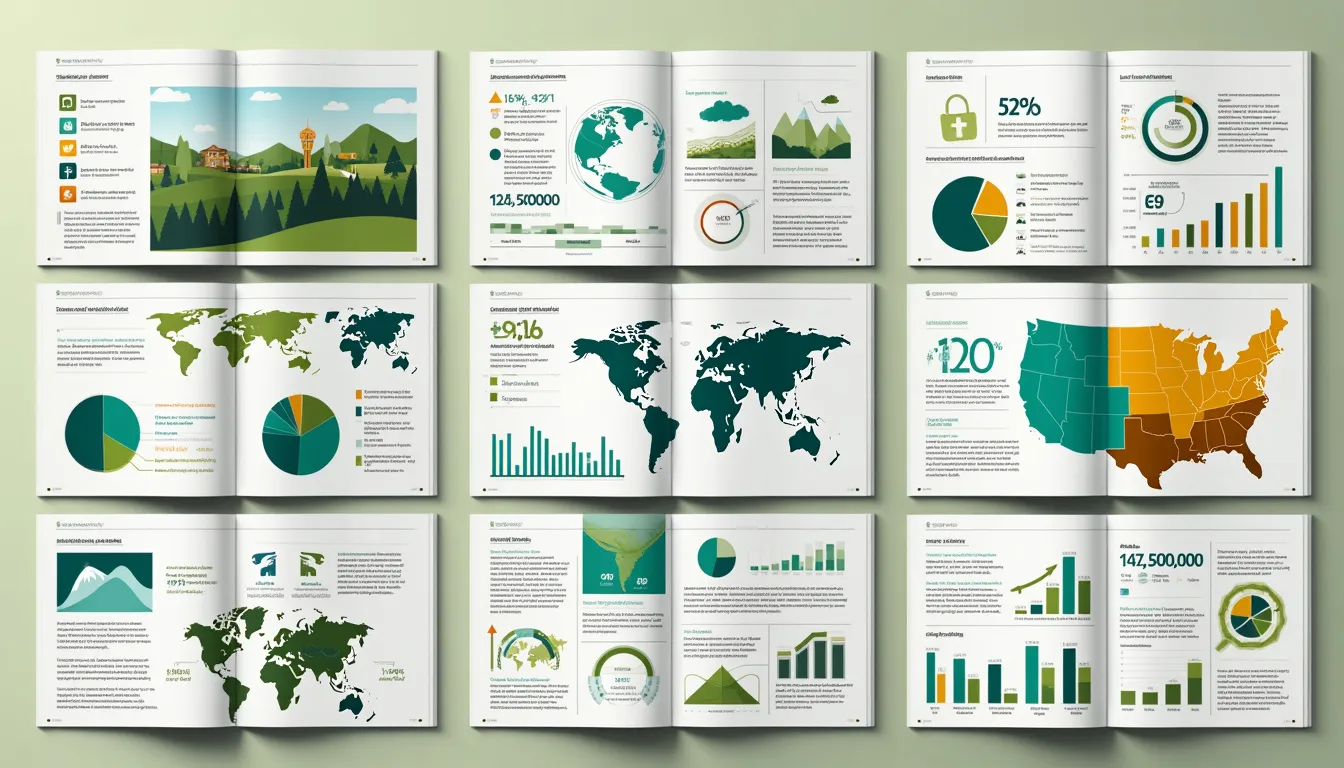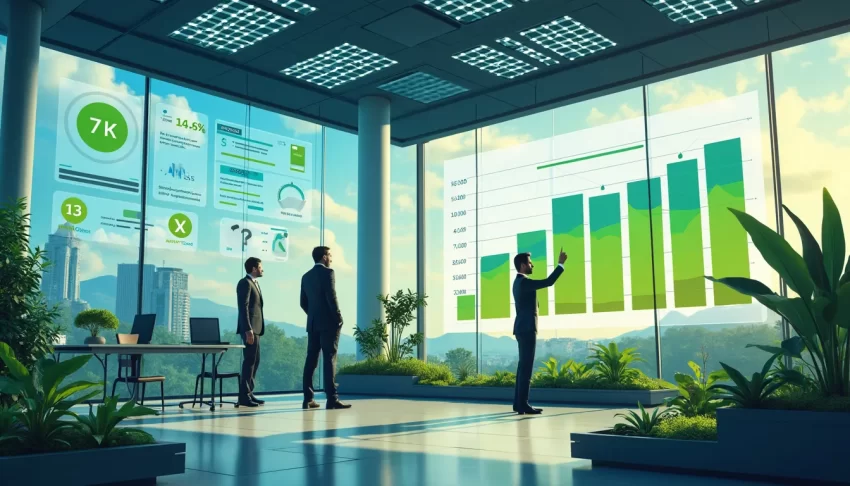In an era where environmental consciousness is no longer a choice but a necessity, sustainability reporting has emerged as a pivotal practice for modern businesses. At its core, sustainability reporting involves the disclosure of environmental, social, and governance (ESG) impacts, offering a transparent look into how a company operates concerning sustainability. This practice enables organizations to measure and communicate their environmental and societal contributions and challenges. Beyond merely fulfilling regulatory requirements, sustainability reporting serves as a beacon of corporate responsibility and a crucial tool for fostering trust and engagement among stakeholders.
The concept of sustainability reporting is not entirely new; it has evolved significantly over the decades. Initially, companies focused predominantly on financial performance, with little regard for the environmental or social outcomes of their operations. However, growing awareness of climate change, resource depletion, and social justice has reshaped stakeholder expectations and corporate priorities. This shift has fueled the rise of comprehensive sustainability reports that reflect a company’s commitment to sustainable development.
For businesses, the implications of sustainability reporting are profound. It isn’t just about fulfilling an obligation—it’s about embracing a transformative approach that can enhance transparency and accountability. When businesses openly share their sustainability practices and progress, they build stronger relationships with investors, customers, and employees, fostering a sense of trust and engagement. Additionally, companies that integrate robust sustainability practices often see improved financial performance and better risk management, paving the way for long-term success.
As we delve deeper into the vital aspects of sustainability reporting, we’ll uncover the essential elements and metrics that make these reports effective. We’ll explore the frameworks and standards guiding them and highlight best practices for data collection and analysis. Looking ahead, we’ll examine future trends, such as advances in reporting technologies, the integration of sustainability into corporate strategy, and the influence of regulatory changes on reporting practices.
Understanding the significance of sustainability reporting is the first step towards a more transparent, accountable, and sustainable business landscape. Whether you’re an entrepreneur keen on embedding sustainable practices into your enterprise or a seasoned business leader looking to refine your reporting strategies, this guide will offer valuable insights to help you navigate the evolving realm of sustainability reporting.
Introduction to Sustainability Reporting
Definition and Purpose of Sustainability Reporting
Sustainability reporting is a critical process for businesses aiming to transparently disclose their environmental, social, and governance (ESG) impacts. By definition, sustainability reporting involves the systematic collection, analysis, and dissemination of information regarding a company’s sustainability practices. This encompasses everything from carbon footprint and resource usage to workforce diversity and community contributions.
The primary purpose of sustainability reporting is manifold. First and foremost, it allows companies to communicate their sustainability efforts to stakeholders, including investors, customers, employees, and regulatory bodies. This transparency is crucial for fostering trust and enhancing corporate reputation. Additionally, sustainability reporting serves as a tool for internal reflection and improvement. By tracking and analyzing their sustainability metrics, companies can identify areas where they excel and pinpoint opportunities for improvement, ultimately leading to more efficient and responsible business practices.
Brief Historic Overview of Sustainability Reporting
While the concept of sustainability reporting may seem relatively new, its roots extend back several decades. The origins of sustainability reporting can be traced to the environmental movements of the 1960s and 1970s when awareness of environmental issues began to rise sharply. During this period, companies started to recognize the importance of documenting and mitigating their environmental impacts.
One of the early milestones in the evolution of sustainability reporting was the publication of the first environmental reports by companies like General Electric and 3M in the late 1980s and early 1990s. These reports primarily focused on environmental metrics such as emissions, waste, and resource consumption. However, as the understanding of sustainability broadened, so did the scope of these reports.
The 1990s witnessed the emergence of more comprehensive sustainability reporting frameworks. One significant development was the founding of the Global Reporting Initiative (GRI) in 1997. The GRI provided a standardized framework for sustainability reporting, allowing businesses to disclose their ESG performance consistently and comparably. Since then, the GRI guidelines have been widely adopted and have played a pivotal role in shaping modern sustainability reporting practices.
In the 2000s and beyond, sustainability reporting continued to gain traction. This period saw an increased emphasis on the social and governance aspects of sustainability, in addition to environmental concerns. Companies began to incorporate metrics related to labor practices, human rights, and corporate governance into their sustainability reports. This holistic approach provided a more comprehensive view of a company’s overall sustainability performance.
Moreover, the rise of digital technology has revolutionized sustainability reporting. Advanced data collection and analysis tools have made it easier for companies to gather accurate and real-time information about their sustainability performance. This technological progress has also facilitated the creation of interactive and user-friendly sustainability reports that engage a broader audience.
In recent years, the growing demand for transparency and accountability from various stakeholders has further fueled the evolution of sustainability reporting. Investors, in particular, have become increasingly interested in sustainability performance as they recognize its impact on long-term financial stability. This has given rise to the concept of integrated reporting, where financial and sustainability information are combined into a single cohesive report.
Additionally, regulatory bodies worldwide have started to mandate sustainability reporting, enhancing its importance. For instance, the European Union’s Non-Financial Reporting Directive requires large companies to disclose their ESG performance, promoting greater accountability and transparency.
The historical trajectory of sustainability reporting reflects a continuous evolution driven by societal awareness, technological advancements, and regulatory developments. Today, sustainability reporting is recognized as a vital practice for modern businesses striving to operate responsibly and sustainably.
In summary, sustainability reporting serves as a powerful tool for companies to communicate their commitment to sustainability, identify areas for improvement, and meet the growing demands for transparency from stakeholders. Understanding the historical context of sustainability reporting helps us appreciate its significance in the journey toward a more sustainable and accountable business landscape. By embracing and effectively implementing sustainability reporting, businesses can not only enhance their reputation but also contribute to a more sustainable and equitable future.

Benefits of Sustainability Reporting for Businesses
Enhancing Corporate Transparency and Accountability
Sustainability reporting can significantly enhance a company’s transparency and accountability—two pillars essential for cultivating a robust corporate reputation. When businesses openly share how they’re performing on various sustainability metrics, it builds a culture of honesty and openness. According to a report by KPMG, 80% of the world’s largest 250 companies now publish detailed sustainability reports. This transparency allows stakeholders, including customers, employees, and investors, to see the tangible actions being taken toward social responsibility and environmental stewardship.
For example, Unilever publishes an annual sustainability report detailing its progress on initiatives like reducing carbon emissions and promoting fair labor practices. This level of thorough disclosure ensures that stakeholders can hold the company accountable, reinforcing trust and credibility. When stakeholders see that a company genuinely cares about sustainable development, they’re more likely to remain loyal and engaged.
Building Stakeholder Trust and Engagement
Sustainability reporting also helps in building trust and engagement among various stakeholders. Trust is a foundational element for any business striving for long-term success. By providing concrete evidence of their sustainability efforts, companies can engage more effectively with stakeholders. Engaged stakeholders are often more supportive, potentially leading to increased investment, customer loyalty, and a motivated workforce.
Take Patagonia, for instance. This outdoor apparel company is renowned for its robust sustainability reporting. From environmental impact assessments to supply chain transparency, Patagonia’s comprehensive reports foster a deep connection with its community of customers and shareholders. Their open reporting builds trust, making stakeholders feel included in the journey toward a more sustainable future.
A Harvard Business Review article indicated that sustainability efforts, clearly communicated through detailed reporting, could significantly increase stakeholder engagement. When stakeholders feel that a company is genuinely committed to sustainable practices, their trust deepens, and their engagement with the company strengthens, driving overall business performance.
Driving Long-term Financial Performance and Risk Management
One of the most compelling benefits of sustainability reporting lies in its ability to drive long-term financial performance and enhance risk management. Companies that prioritize sustainability often enjoy cost savings, operational efficiencies, and a healthier bottom line. The Global Reporting Initiative notes that companies engaged in sustainability reporting can manage risks more effectively, adapt to changing market conditions, and seize new opportunities for growth.
Businesses that implement robust sustainability practices typically see reduced waste and energy costs. For example, Walmart’s sustainability reporting includes significant strides in reducing its carbon footprint and investing in renewable energy sources. These initiatives not only contribute to a more sustainable planet but also translate into substantial cost savings, benefiting Walmart’s overall financial performance.
Moreover, sustainability reporting allows companies to identify potential risks early. Whether it’s regulatory risks, changing consumer preferences, or supply chain vulnerabilities, having a clear sustainability strategy helps businesses adapt and pivot in response to these challenges. This proactive approach is crucial for long-term viability, ensuring that companies are not just surviving but thriving in a rapidly evolving landscape.
Data supports this as well. A study by McKinsey & Company found that companies with strong ESG (Environmental, Social, and Governance) propositions often achieve better equity returns and exhibit lower volatility. By integrating sustainability reporting into their core operations, businesses can enhance their resilience against market shifts and unexpected disruptions.
Overall, sustainability reporting offers a multitude of benefits that extend far beyond compliance. From enhancing transparency and building trust to driving financial performance and effective risk management, the practice serves as a strategic asset in a competitive business landscape. By openly sharing their sustainability efforts, businesses not only contribute to a more sustainable future but also position themselves for enduring success.

Key Elements of an Effective Sustainability Report
Essential Content and Metrics to Include
Creating a compelling and informative sustainability report starts with understanding what content and metrics are essential. Typically, an effective sustainability report should cover various aspects of economic, environmental, and social performance.
Economic Performance: Start by detailing your company’s economic contributions, including revenue streams, job creation, and community investments. Highlight how sustainability initiatives have impacted the bottom line, showcasing both immediate and long-term financial benefits.
Environmental Performance: Metrics related to resource consumption (such as energy, water, and raw materials), waste generation, and carbon footprint forms the crux of environmental performance. Additionally, outlining initiatives like recycling programs or energy-saving projects provides concrete examples of your commitment to environmental stewardship.
Social Performance: Here, focus on metrics related to labor practices, including employee diversity, training programs, and health and safety measures. Community engagement initiatives and any projects aimed at improving local well-being also fall under this category.
Incorporating these elements ensures that stakeholders have a holistic view of your sustainability efforts and their impacts.
Reporting Frameworks and Standards (e.g., GRI, SASB)
To add credibility to your sustainability report, aligning with established reporting frameworks and standards is crucial. These frameworks offer guidelines on what to report and how to present the information, making your data not only consistent but also comparable across industries.
Global Reporting Initiative (GRI): One of the most widely used frameworks, GRI provides comprehensive guidelines that cover a vast array of sustainability topics. GRI standards are designed to be modular and interrelated, allowing businesses to focus on the areas most relevant to them.
Sustainability Accounting Standards Board (SASB): SASB focuses on financially material sustainability information and guides what should be disclosed in regulatory filings. The framework is particularly useful for companies looking to integrate sustainability reporting with financial disclosures.
Task Force on Climate-related Financial Disclosures (TCFD): This framework is geared specifically towards climate-related financial risk. It offers recommendations on disclosing how climate change impacts governance, strategy, and risk management processes.
Best Practices for Data Collection and Analysis
The backbone of an effective sustainability report is robust data collection and analysis processes. Getting this right can significantly enhance the accuracy and credibility of your report.
Centralize Data Collection: One effective strategy is to centralize your sustainability data collection. Use cloud-based platforms to gather data from various departments and locations, ensuring all information is stored in one accessible place.
Regular Audits: Conduct regular audits to verify the collected data. Third-party verification adds an extra layer of credibility and ensures your data is reliable.
Employee Training: Training employees involved in data collection about the importance of accuracy and consistency can also lead to more reliable reporting. Equip them with the necessary tools and knowledge to gather and report data effectively.
Use Data Analytics Tools: Leveraging data analytics tools can help you draw meaningful insights from your data. These tools can identify trends, highlight areas needing improvement, and measure the impact of sustainability initiatives.
Engage Stakeholders: Early engagement with stakeholders in the data collection phase can lead to more comprehensive reporting. Stakeholders, including employees, customers, and investors, can provide valuable insights into what information is most relevant and impactful to them.
By focusing on these key elements, you can ensure your sustainability report is not only effective but also a true reflection of your company’s values and commitment to sustainable practices. This, in turn, can strengthen your brand, build trust among stakeholders, and drive long-term success.

Future Trends in Sustainability Reporting
As the urgency for sustainable practices continues to rise, the realm of sustainability reporting is evolving rapidly. Modern businesses are increasingly recognizing that robust sustainability reporting not only responds to growing stakeholder expectations but also paves the way for future-proofing operations. In examining the future of sustainability reporting, we’ll cover advances in technology, the integration of sustainability into corporate strategies, and the role of regulatory changes and international agreements.
Advances in Reporting Technologies and Tools
One of the most notable trends in sustainability reporting is the development of advanced reporting technologies and tools. These innovations are streamlining the process of data collection, analysis, and reporting, making it easier and more accurate for businesses to assess and communicate their sustainability performance.
For instance, the rise of artificial intelligence (AI) and machine learning is transforming how organizations handle sustainability data. AI-powered analytics can sift through vast amounts of information to identify patterns, predict outcomes, and suggest improvements. This capability allows businesses to not only report on past and present performance but also to foresee future trends and make proactive adjustments.
Another significant technological trend is the use of blockchain for sustainability reporting. Blockchain’s transparent and immutable ledger ensures that reported data is accurate and tamper-proof, increasing transparency and trust among stakeholders. This technology is particularly valuable in supply chain management, where it can trace the origin and journey of products, ensuring adherence to sustainability standards.
Cloud-based platforms are also gaining traction, offering scalable and flexible solutions for managing sustainability data. These platforms allow businesses of all sizes to collect, analyze, and report on sustainability metrics without the need for substantial investment in IT infrastructure. The accessibility and real-time capabilities of cloud-based solutions make it easier for companies to stay up-to-date with their sustainability goals and compliance requirements.
Integrating Sustainability into Corporate Strategy
In the future, sustainability reporting will become increasingly integrated into overall corporate strategy rather than being seen as a standalone or peripheral activity. This integration is crucial for achieving long-term sustainability goals and ensuring that sustainability considerations are embedded in all aspects of business decision-making.
One way this integration manifests is through the alignment of sustainability goals with core business objectives. Companies are beginning to recognize that sustainability is not just about mitigating negative impacts but also about creating value. By incorporating sustainability into their strategic planning, businesses can identify opportunities for innovation, cost savings, and competitive advantage.
For example, companies that prioritize energy efficiency and renewable energy not only reduce their carbon footprint but also lower operational costs. Businesses that focus on sustainable product design and packaging can appeal to the growing market of eco-conscious consumers, driving sales and brand loyalty.
Furthermore, sustainability reporting can help businesses identify and manage environmental, social, and governance (ESG) risks, which are increasingly viewed as critical to long-term financial performance. By proactively addressing ESG issues, companies can enhance their resilience, attract investment, and ensure regulatory compliance.
A leading example of this integration is Unilever, which has embedded sustainability into its corporate strategy through the Unilever Sustainable Living Plan. This strategy not only sets ambitious sustainability targets but also links them to the company’s growth and profitability goals. As a result, Unilever has improved its environmental impact, strengthened its brand reputation, and driven significant financial value.
The Role of Regulatory Changes and International Agreements
Regulatory changes and international agreements are also shaping the future of sustainability reporting. Governments and international bodies are increasingly mandating transparency and accountability when it comes to sustainability, and businesses must stay abreast of these developments to ensure compliance.
The European Union, for instance, has introduced the Corporate Sustainability Reporting Directive (CSRD), which significantly expands the scope and requirements of sustainability reporting for companies operating within the EU. The CSRD mandates that businesses disclose detailed information on their environmental and social impacts, as well as governance practices, ensuring a higher level of corporate transparency.
International agreements such as the Paris Agreement also play a crucial role in driving sustainability reporting. The commitment to limiting global warming to well below 2 degrees Celsius urges countries—and, by extension, businesses—to adopt stringent measures to reduce greenhouse gas emissions. Sustainability reporting becomes a vital tool in tracking progress toward these targets and demonstrating accountability.
The Task Force on Climate-related Financial Disclosures (TCFD) is another influential framework that is shaping the future of sustainability reporting. The TCFD provides recommendations for disclosing climate-related financial risks and opportunities, making it easier for investors to assess how companies are managing climate risks. As more investors prioritize ESG criteria in their decision-making, adherence to TCFD recommendations is becoming increasingly important for businesses seeking to attract capital.
Embracing these regulatory changes and international agreements may seem challenging, but they also present opportunities for businesses to lead in sustainability and drive positive change. By staying ahead of regulatory requirements and aligning with global sustainability goals, companies can enhance their reputation, build stakeholder trust, and achieve long-term success.
Conclusion
To sum up, the future of sustainability reporting is marked by technological advancements, deeper integration into corporate strategies, and evolving regulatory landscapes. Businesses that embrace these trends stand to gain not only in terms of regulatory compliance but also in achieving long-term profitability and sustainability. By leveraging advanced tools, embedding sustainability into their core strategies, and staying mindful of regulatory and international frameworks, companies can lead the way towards a more sustainable future. So, whether you’re a business owner looking to enhance your sustainability practices or an individual seeking to understand the broader landscape, staying informed about these trends is essential.
As we conclude our exploration of sustainability reporting, it’s clear that this practice is not merely a trend but a vital component of modern business strategy. By documenting and disclosing their environmental, social, and governance (ESG) activities, companies can considerably enhance their corporate transparency and accountability. This transparency fosters trust and engagement among stakeholders, from investors to customers, and even employees, driving loyalty and long-term success.
The benefits of sustainability reporting are manifold. Beyond improving transparency, it acts as a powerful tool for risk management and long-term financial performance. Businesses that commit to sustainability are better prepared for future challenges and are often viewed favorably by the market, which can translate into tangible financial gains and a stronger competitive edge.
Creating an effective sustainability report involves careful consideration of what content and metrics to include. Utilizing well-respected reporting frameworks like the Global Reporting Initiative (GRI) and the Sustainability Accounting Standards Board (SASB) can help ensure that the reports are comprehensive and comparable. Collecting and analyzing accurate data may seem daunting, but employing best practices in this area can demystify the process and result in insightful, actionable reports.
Looking ahead, the future of sustainability reporting is bright and ever-evolving. Technological advances are making data collection and reporting more efficient and precise. Additionally, the increasing integration of sustainability into overall corporate strategy signifies a shift towards a more holistic approach to business operations. As regulatory changes and international agreements continue to emphasize the importance of sustainability, staying ahead of these trends will be crucial for businesses aiming to lead in their industries.
Now, more than ever, is the time to take action. For individuals and business owners eager to make a difference, start small but think big. Whether you’re implementing recycling programs in your office, choosing suppliers with strong ESG commitments, or investing in technologies that reduce environmental impact, every effort counts.
Embrace sustainability reporting not just as a compliance requirement, but as an opportunity to showcase your commitment to a better, more sustainable future. By doing so, you’ll not only contribute to global sustainability goals but also unlock new dimensions of value and resilience for your business.
Support Us: Check out our recommended products on Amazon.

